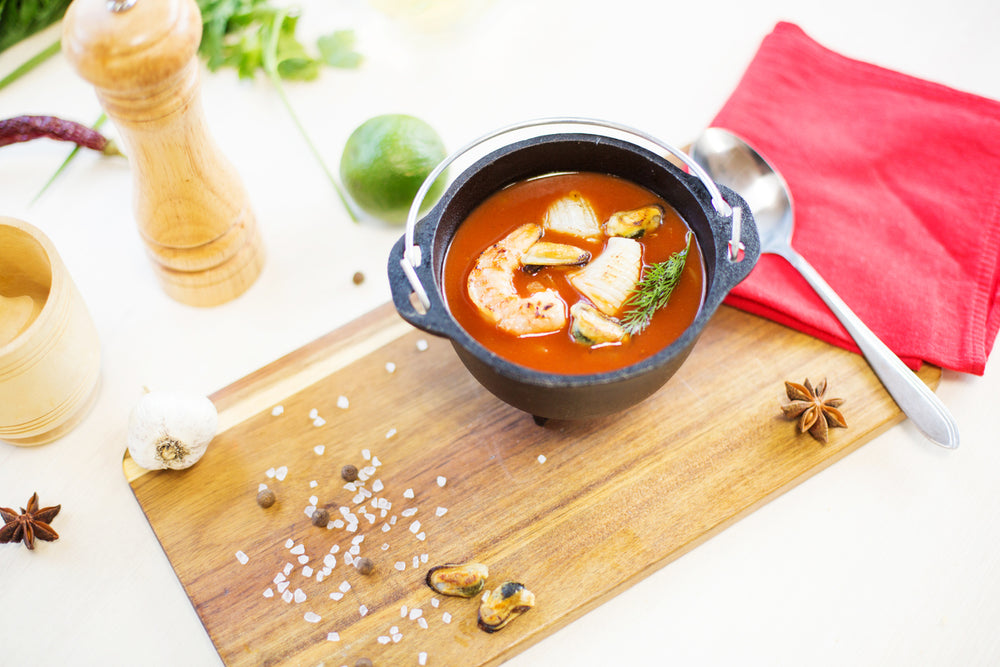In Britain, curries are as fundamental to British cuisine as fish and chips, roast beef, and Yorkshire puddings. The presence of the British in India played a role in how and why this happened. The British army and civilians stationed in India grew accustomed to the hot, spiciness of the cuisine and brought the curries back to their homes and other regions of the former British Empire. The dishes that are now regarded as traditional British foods—Mulligatawny soup and Kedgeree were two of the most notable curries—that were frequently adapted from Indian foods to suit the lighter palate in Britain.
Origin of British Curries

We must travel back in time to the colonial era to discover the origins of British curries. The extensive global reach of the British Empire brought back not only goods and resources but also a wide variety of spices and culinary customs. The 'Hindoostanee Coffee House', the first known curry house in Britain, was founded in London in the late 18th century and gave the locals a taste of Indian flavours. This signalled the start of a culinary revolution that would always influence British cuisine.
The Culture of Curry House
The phrase curry house has come to represent the British food culture. These businesses, which are frequently family-run and located throughout cities and towns, serve a varied menu that goes beyond classic curries. Each curry house boasts its own take on these classic dishes, from creamy Kormas to fiery Vindaloos. The communal nature of food in both British and South Asian cultures is further reflected in the curry house culture, which has evolved into a focal point for neighbourhood celebrations and gatherings.
Chicken Tikka Masala Britain’s Favourite Curry
After former foreign secretary Robin Cooke praised Chicken Tikka Masala as "Britain's real national dish," controversy erupted across the entire United Kingdom. Irrespective, the British love this dish.
It was created 500 years ago, during the conquest of Punjab by Babur, a warlord descended from the Mongol warlord Genghis Khan. Back then, it wasn't much like the Chicken Tikka curries we are familiar with today. Indian restaurants popped up all over the country in the 1950s due to the country's heavy immigration from the Indian subcontinent. The British wanted a sauce or gravy to go with their Chicken Tikka, so the Masala (the creamy sauce) was introduced.
Lamb Rogan Josh

Lamb Rogan Josh is a popular British curry that has its roots in Kashmiri cuisine. This stew is made from tender lamb that has been slow-cooked and flavored with various aromatic spices. The sauce's allure is enhanced by the deep red hue that Kashmiri chillies give it.
Dishoom, Tayyabs, and Gymkhana in London, along with Akbar's in Birmingham, are some of the most well-known places known for serving this aromatic delight. These curry restaurants are renowned for their true-to-life renditions of Lamb Rogan Josh, providing connoisseurs with a memorable dining experience.
Balti
A culinary sensation, balti curry was created by Birmingham's thriving South Asian community. The Balti offers a distinctive medley of spices and ingredients and is named after the steel dish it is cooked and served in. Curry lovers all over the UK have fallen in love with it thanks to its unique flavour and presentation.
It comprises stir-fried marinated meats or vegetables with various spices including coriander, cumin, and turmeric. Fresh tomatoes, peppers, and onions are added to this flavuorful mixture as it cooks in a wok-like "balti" pan to produce a bold, aromatic curry that is renowned for both its taste and appearance.
Beef Madras
Beef Madras is a robust and fiery British curry that tastes buds on a journey of flavour and spice. This dish, which comes from the southern Indian city of Madras (now Chennai), is made of tender beef that has been simmered in a flavourful mixture of aromatic spices like cardamom, cumin, and red chillies.
The intense heat of the dish can be balanced by adding a creamy and slightly sweet undertone of coconut milk or coconut cream, which also creates a flavourful harmony that lingers on the palate.
Chicken/Vegetable Bhuna

Chicken or vegetable bhuna is distinguished by its elegance and complex flavours. In this dish, a medley of vegetables or marinated chicken is sautéed with a mixture of spices until their natural juices are released.
The ingredients of this contribute to its rich, aromatic flavour, which is achieved through slow cooking. The final result is a hearty and satisfying dish that preserves the flavour of each ingredient in every bite.
Vegetable Jalfrezi
A celebration of hues and textures, vegetable jalfrezi is a lively and colourful British curry. This dish has Indian origins, and several colourful, fresh vegetables are used in its making. These chopped vegetables are sautéed with flavourful herbs and spices like cumin, coriander, and chillies.
Tomatoes and bell peppers are added for a tangy sweetness to create a pleasing balance that highlights the freshness of the vegetables. Every forkful of vegetable jalfrezi offers a delightful explosion of flavours, making it a feast for the eyes and the palate.
Chicken/Vegetable Korma
Chicken or Vegetable Korma is a rich British curry that offers a taste of luxury and warmth. This dish is inspired by Mughlai cuisine and is made with tender pieces of marinated chicken or a variety of vegetables cooked in a delicious creamy sauce.
Cardamom, cinnamon, and nutmeg are the main spices of this curry. They are added to the sauce to enhance the flavour and create an aromatic and gratifying symphony of tastes. To further enhance the richness and add a little texture to the dish, nuts, and dried fruits are added to transform it into a culinary masterpiece befitting of royalty as it adds a delightful texture and a pinch of sweetness.
Conclusion

These curries celebrate diversity and continue to bring people together on all tastes and, in all ways, capture the spirit of a multicultural Britain.


 Easter 2026
Easter 2026
 Frozen Food
Frozen Food
 Baking
Baking
 Beans, Peas, Soups & Tins
Beans, Peas, Soups & Tins
 Biscuits, Crackers & Cookies
Biscuits, Crackers & Cookies
 Candy / Sweets
Candy / Sweets
 Crisps & Snacks
Crisps & Snacks
 Chemist / Pharmacy
Chemist / Pharmacy
 Desserts
Desserts
 Gravy, Stock & Paste
Gravy, Stock & Paste
 Haggis
Haggis
 Indian Sauces, Paste and Pickle
Indian Sauces, Paste and Pickle
 Jams & Preserves
Jams & Preserves
 Poppy Appeal
Poppy Appeal
 Pot Noodles & Super Noodles
Pot Noodles & Super Noodles
 Scone Mix
Scone Mix
 Gluten-Free / Free From
Gluten-Free / Free From
 Tea Accessories
Tea Accessories
 Teapot & Tea sets
Teapot & Tea sets
 Tea For One
Tea For One
 Sugar & Creamer
Sugar & Creamer
 Tableware
Tableware
 Serveware
Serveware
 Plates & Trays
Plates & Trays
 Bowls
Bowls
 Cups & Saucers
Cups & Saucers
 Mugs
Mugs
 Silverware
Silverware
 Dinnerware - Accessories
Dinnerware - Accessories
 Dinnerware - For Pets
Dinnerware - For Pets
 Victoria Eggs - Hand-Drawn UK Homeware
Victoria Eggs - Hand-Drawn UK Homeware
 Jewelry & Accessories
Jewelry & Accessories
 Sale
Sale
 Christmas Gifts
Christmas Gifts

